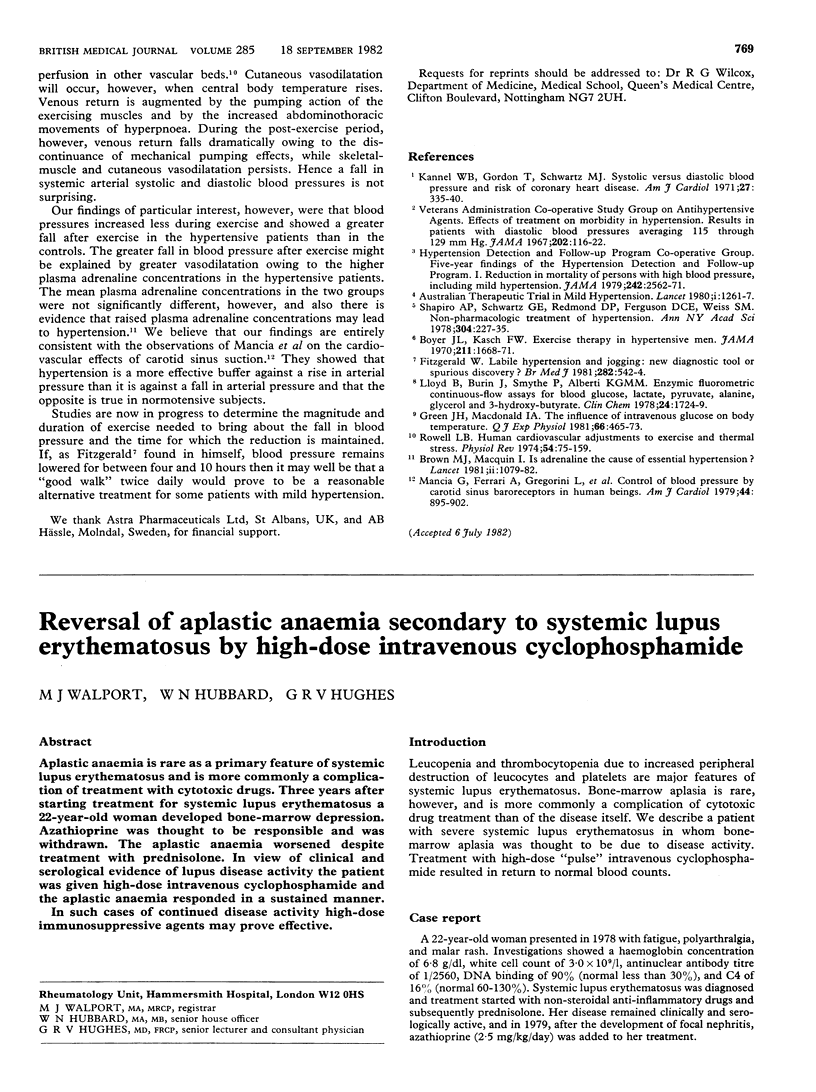Abstract
Ten men with uncomplicated essential hypertension (mean standing blood pressure 165/109 mm Hg) and 10 normal controls matched for age and weight were studied for the hypotensive potential of moderate exercise. Tests were conducted on a treadmill set to induce a steady heart rate of 120 beats/min and performed over five 10-minute periods separated by three minutes' rest and finishing with 30 minutes' sitting quietly in a chair.
During exercise the mean systolic pressures were identical in the hypertensive patients and controls (175±SEM 5 mm Hg), the controls therefore sustaining an appreciably greater increase in pressure. During the 30-minute rest period after the tests both the control and hypertensive groups showed a significant and sustained fall in absolute systolic pressures as compared with pre-exercise values (p <0·001), the mean percentage reductions being 22% and 25% respectively.
If a fall in blood pressure after exercise is maintained for four to 10 hours, then a “good walk” twice a day might be reasonable treatment for mild hypertension. Studies are continuing to determine the amount of exercise needed and the duration for which the reduction in blood pressure is maintained.
Full text
PDF


Selected References
These references are in PubMed. This may not be the complete list of references from this article.
- Boyer J. L., Kasch F. W. Exercise therapy in hypertensive men. JAMA. 1970 Mar 9;211(10):1668–1671. [PubMed] [Google Scholar]
- Brown M. J., Macquin I. Is adrenaline the cause of essential hypertension? Lancet. 1981 Nov 14;2(8255):1079–1082. doi: 10.1016/s0140-6736(81)91279-4. [DOI] [PubMed] [Google Scholar]
- Fitzgerald W. Labile hypertension and jogging: new diagnostic tool or spurious discovery? Br Med J (Clin Res Ed) 1981 Feb 14;282(6263):542–544. doi: 10.1136/bmj.282.6263.542. [DOI] [PMC free article] [PubMed] [Google Scholar]
- Green J. H., Macdonald I. A. The influence of intravenous glucose on body temperature. Q J Exp Physiol. 1981 Oct;66(4):465–473. doi: 10.1113/expphysiol.1981.sp002588. [DOI] [PubMed] [Google Scholar]
- Kannel W. B., Gordon T., Schwartz M. J. Systolic versus diastolic blood pressure and risk of coronary heart disease. The Framingham study. Am J Cardiol. 1971 Apr;27(4):335–346. doi: 10.1016/0002-9149(71)90428-0. [DOI] [PubMed] [Google Scholar]
- Lloyd B., Burrin J., Smythe P., Alberti K. G. Enzymic fluorometric continuous-flow assays for blood glucose, lactate, pyruvate, alanine, glycerol, and 3-hydroxybutyrate. Clin Chem. 1978 Oct;24(10):1724–1729. [PubMed] [Google Scholar]
- Mancia G., Ferrari A., Gregorini L., Parati G., Ferrari M. C., Pomidossi G., Zanchetti A. Control of blood pressure by carotid sinus baroreceptors in human beings. Am J Cardiol. 1979 Oct 22;44(5):895–902. doi: 10.1016/0002-9149(79)90220-0. [DOI] [PubMed] [Google Scholar]
- Rowell L. B. Human cardiovascular adjustments to exercise and thermal stress. Physiol Rev. 1974 Jan;54(1):75–159. doi: 10.1152/physrev.1974.54.1.75. [DOI] [PubMed] [Google Scholar]


